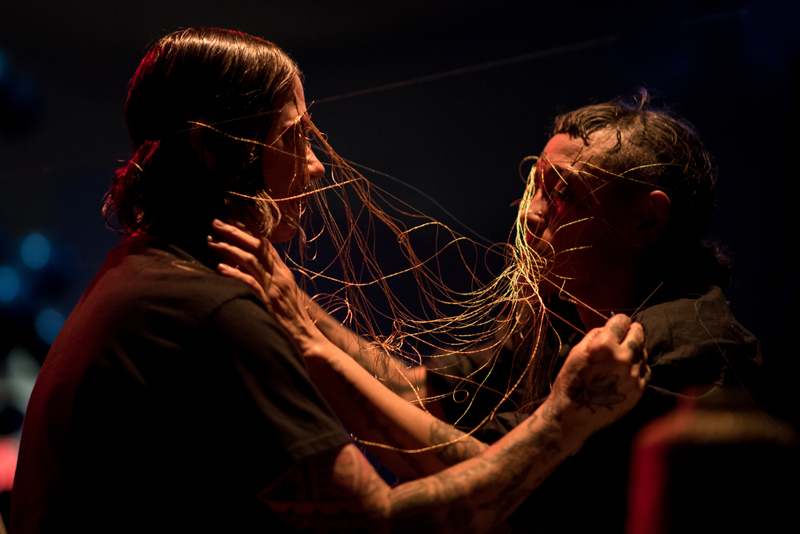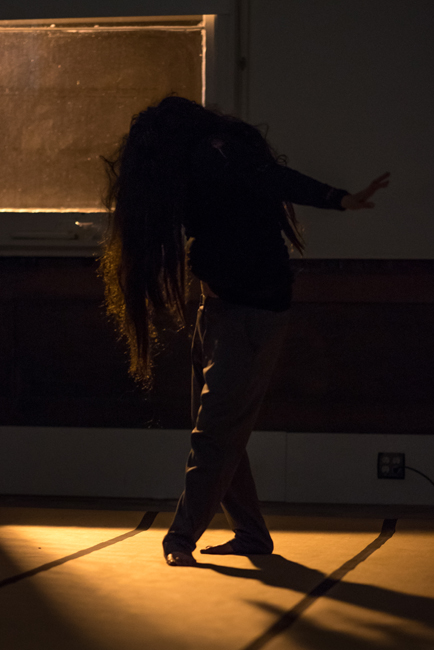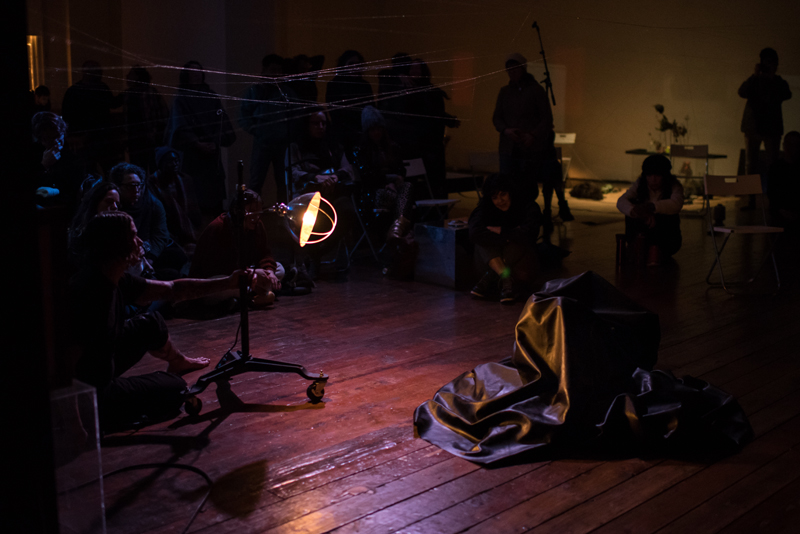Entangled Vulnerabilities: Julie Tolentino’s .bury.me.fiercely.

From Julie Tolentino’s .bury.me.fiercely., performed at The Lab, February 18, 2018. All photos: Hillary Goidell.
Upon arrival at The Lab on an unusually windy February night, I encountered punctuations throughout the space that Julie Tolentino would map out during her impending performance. (Ritual.) Among these was an altar. A mirror rested behind a burning pot of flowers and leaves, exuding an herbaceous scent that slowly infiltrated and awakened my senses. In response to Tolentino’s invitation to engage with the elements on display, I proceeded to isolate and scan my senses, attending to their slow rhythmic responses. By conveying them here, I add another layer to her processual, communal burial.
The burial suggested by the title is fragmented, as if the artist is imploring us to pause, to rest, as we consider her peculiar invocation. .bury.me.fiercely. Rests. 1 In Tolentino’s title, punctuation inversions mark time, an action, an elusive subject/object, an adverb. Fiercely. She demands. Not by accident. Nor by force. 2 Here, the artist asks us to pause. Before witnessing her revelation. Before burying her. Fiercely. As fiercely as she has been living her life for decades, from coast to coast, continent to continent, as an activist and artist of many forms — among them, live performance, performance as documentation, and the creation of queer night culture.
As an artist and archivist, I situate myself accordingly, offering my own archive of feelings 3 and sensations, which are activated by Tolentino’s ritual generosity and explicit body, itself tethered to the body in pain. 4
Rhythms / Sounds
Her feet draw whispers across the paper floor in concert with the fragmented words projected onto the wall beside her. She begins the process of writing the body, her feet remembering the silhouettes traced on the ground. 5 She dances like a tree in the wind, on this windy night, her limbs tracing enigmatic silhouettes in the air, capturing the excess of her hair and its shadows. Rhythms pulse slowly and fluidly. They run deep throughout my body, especially close to the root.
The sounds of her tracings on the floor form a score for the arranger, Cirilio Domine, in front of her. He sets up flowers, leaves, and branches, all in a state of metamorphic decay. He searches for ways to bring them to life, or at least to a liminal state. Her face is obscured by an excess of hair, an overgrowth, which carries its own stories. After she removes the excess and places it on the ground, she positions herself beside the arranger. In stillness, they appreciate the arrangement of residual earth before them. Rest.

Touches / Textures
An attendant, Pigpen/Stosh, meets her in the center of the space. A precarious performance unravels, in which the tactile and the visual intertwine gently. 6 The texture shifts back and forth from softness to sharpness: a face-to-face encounter, one like Lévinas had never imagined. 7
As this delicate encounter unfolds, the attendant begins to pierce needles into Tolentino’s face, above her eyes and mouth. The precise care of this action is matched by the arranger, who threads a clear wire throughout the space, connecting the pillars and vertical structures that surround them and us. Them and us. As if there were such a separation.
I imagine the transparent wire as if it were the fascia of her body — this corporeal dwelling in which I momentarily reside. The fascia cuts through the flesh of the space, as the arranger creates punctuations that form a zigzag structure. It is taut, unlike the yarn that the two performers in the center continue to wrap around and around each other’s heads. The yarn has a life of its own, becoming increasingly entangled. It works its way around the needles that rest on the fragility of their interwoven faces.
Affects
The piercings are removed. Gently. Blood streams down her face from the broken skin above her pretty mestiza eyes. 8 Cathartic. Blood memories release through purifying tears. 9 My breath is interrupted. I become hyperaware of the skin on my face. My awareness is gathered above and below my eyes, my lips, producing a vibrating sensation, where the affective and tactile meet. As an embodied spectator, I am left feeling vulnerable in our entanglement. Rest.

Images
They move closer to the altar. Black balloons become black air molecules; a large blanket of black plastic awaits Tolentino’s processual metamorphosis. With generous hands, her collaborator contains the blood memory streaming from her forehead, as if to refuse abjection, or perhaps hold it closer. Other textures emerge from this space of dematerialization where the body becomes legible before becoming illegible. Brown and red flesh tones amid the black plastic are met with soft white cotton. The white material appears as clouds she gathers close to her body. A moist rag, thick with red, lies beside her, juxtaposed against the black that envelops her. Rest.
For the final moment that occurs in the center of the space, she is submerged under a large black vinyl mass. The amorphous shape begins to move and flashes of flesh — hands and feet — emerge from underneath, accented by a small moving light on wheels operated by her collaborator.

Aesthetics of Blood
Before the aesthetics of blood were instrumentalized in the postwar performance art world, 10 indigenous people performed their own blood rituals, from Mesoamerican flesh offerings to Babaylan blood rituals — before, during, and after colonization and all the spectacular violence that came with it. Perhaps such healing rituals and violent displays are sediments in the recesses of Tolentino’s body-memory — a product of inter- and intracontinental miscegenation — a body that exists in the spaces between theater and anthropology while citing/sighting the other history of intercultural performance. 11 Shuttling between legibility and illegibility, pornography and ethnography, 12 she enacts radical remembrance, as if to ask, “What does it mean to hold another’s blood memory”?
At a time grossly characterized by dissociation, disembodiment, and unsustainable speeds that result in both embodied and psychic amnesias, what is left to do? Tolentino’s .bury.me.fiercely. proposes a pause. A rest. In stillness, as we listen and feel the blood that flows through each of our bodies, in recognition of our enmeshed fragility. 13
- “A (rest). Take a little time, a pause, a breather; make a transition.” Suzan-Lori Parks, “From Elements of Style” in The America Play and other works (New York: Theatre Communications Group, 1995), 16.
- In this spatial vicinity, the case of Cecelia Navarro — a Filipina who migrated to Stockton — drew national attention when she was buried alive in 1933 for supposedly committing infidelity and adultery. See Dawn Malabuyo, Little Manila is in the heart: the making of the Filipina/o American community in Stockton, California (Durham: Duke University Press, 2013), 161. In this temporal vicinity, just weeks ago, a thirty-seven year old woman in Brazil was mistakenly buried alive. See Alina Polianskaya, “Woman ‘buried alive tried to fight way out of coffin for 11 days, family say,” The Independent, accessed February 22, 2018, http://www.independent.co.uk/news/world/americas/woman-buried-alive-coffin-brazil-11-days-rosangela-almeida-dos-santos-a8213646.html.
- See Ann Cvetkovich, An archive of feelings: trauma, sexuality, and lesbian public cultures. (Durham, NC: Duke University Press, 2003).
- See Rebecca Schneider, The explicit body in performance (London: Routledge, 1997) and Elaine Scarry, The body in pain: the making and unmaking of the world (New York: Oxford University Press, 1987).
- The silhouettes I imagine are reminiscent of previous decades of embodied activism, such as ACT UP’s “die-ins” memorialized by artists like Rudy Lemcke, who made tracings of silhouettes on the ground of the de Young Museum during his performance installation Immemorial (1996).
- Maurice Merleau-Ponty, “The Intertwining—The Chiasm” in The Merleau-Ponty Reader, ed. Ted Toadvine and Leonard Lawlor (Evanston, IL: Northwestern University Press, 2007), 393-413.
- Emmanuel Lévinas and Philippe Nemo, “The Face” in Ethics and Infinity (Pittsburgh: Duquesne University Press, 1985), 85-90.
- Julie Tolentino, “Mestiza: que bonitos ojos tienes” (Mestiza: what pretty eyes you have), performance (1998).
- On “blood memory” as ancestral memory, see articles about and performance texts by Black lesbian ritual jazz theater pioneer, Sharon Bridgforth, particularly her work titled blood pudding.
- Some notable examples of queer artists and artists of color from around the world include Ana Mendieta’s Santería and Yoruba-inspired ritual aesthetics (Untitled—Blood and Feathers #2, 1974; Untitled—Death of a Chicken, 1972; Untitled—Self-Portrait with Blood, 1973); Butoh artist Tatsumi Hjikata’s performances in the ’60s and ’70s involving blood on stage; Letícia Parente and Sonia Andrade, two Brazilian women artists working in the aftermath of the country’s dictatorship in the ’70s, whose video performance pieces documented the action of sowing directly into their own flesh; Franko B.’s most memorable cat walk at The Tate (I Miss You, 2003); Ron Athey’s body of work in the ’90s involving ritual body manipulations combined with religious as well as S&M iconography; and more recently, Rafa Esparza’s offering of flesh to his Mesoamerican ancestors, in his work titled Tezcalipoca Dreams, which he recently discussed during his artist talk at the Stanford Vital Signs Guest Artist Series on February 13, 2018.
- See Richard Schechner, Between Theater and Anthropology (Philadelphia: University of Pennsylvania Press, 1985). Schechner and his colleague, the cultural anthropologist Victor Turner, were interested in the notion of “intercultural performance,” which often entailed re-enacting rituals from the non-Western world in a Western context. For a critical interpretation of “intercultural performance,” see Coco Fusco’s “The Other History of Intercultural Performance” in English in Broken Here (New York City: New Press, 1995), in which she suggests that the roots of this genre of performance — popularized and fetishized by European American scholars in the ’70s and ’80s — were the exploitative ethnographic displays of non-white people in world’s fairs, circuses, and freak shows of the nineteenth and twentieth centuries.
- “She — the iconic and denigrated black female — is the object of pornographic, scientific, and ethnographic looks that continually render her aberrant.” Nicole Fleetwood, “Excess Flesh: Black Women Performing Hypervisibility” in Troubling Vision: Performance, Visuality, and Blackness (Chicago: University of Chicago Press, 2011), 118. Fleetwood is one of many feminist scholars and artists of color whose work historically engages the intersection between pornographic and ethnographic representations of women of color. In “Excess Flesh,” She analyzes performance-based works by artists such as Renee Cox and Tracey Rose that reimagine the “Hottentot Venus,” the South African woman (Sarah Baartman) who was displayed in freak shows in London and Paris in the early nineteenth century.
- Deep thanks to my colleague Rebecca Ormiston for providing feedback on an early draft of this piece.